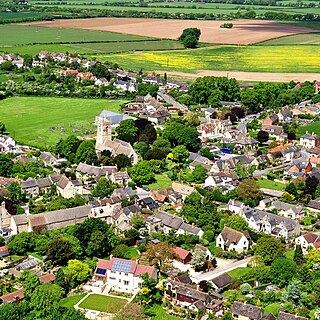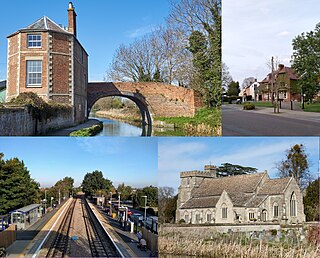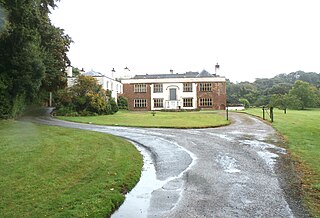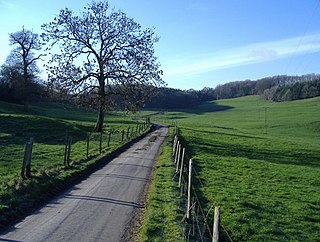| Hawling Manor | |
|---|---|
 Hawling church and manor house | |
| Location | Hawling, Gloucestershire, England |
| Coordinates | 51°54′16.92″N01°54′36.36″W / 51.9047000°N 1.9101000°W |
Hawling Manor in Hawling, Gloucestershire is a Grade II listed building. [1]
| Hawling Manor | |
|---|---|
 Hawling church and manor house | |
| Location | Hawling, Gloucestershire, England |
| Coordinates | 51°54′16.92″N01°54′36.36″W / 51.9047000°N 1.9101000°W |
Hawling Manor in Hawling, Gloucestershire is a Grade II listed building. [1]
Information from Country Life [2] states that the manor "was held in 1066 by the Countess Goda, sister of Edward the Confessor...." The present building dates from the 16th century, with some additions and alterations from the 17th through to the 20th century, with St Edward's Church next door, according to Country Life.
James Holder, co-founder of SuperGroup plc until June 2016, [3] is the current owner of Hawling Manor. [4]

Oxfordshire is a ceremonial county in South East England. The county is bordered by Northamptonshire and Warwickshire to the north, Buckinghamshire to the east, Berkshire to the south, and Wiltshire and Gloucestershire to the west. The city of Oxford is the largest settlement and county town.

Llantwit Major is a town and community in Wales on the Bristol Channel coast. It is one of four towns in the Vale of Glamorgan, with the third largest population after Barry and Penarth, and ahead of Cowbridge. It is 4+1⁄2 miles (7.2 km) from Cowbridge, 9 miles (14 km) from Bridgend, 10 miles (16 km) from Barry, and 15 miles (24 km) from Cardiff. It had a population of 9,530 in 2021.

Stonehouse is a town in the Stroud District of Gloucestershire in southwestern England.

Greys Court is a Tudor country house and gardens in the southern Chiltern Hills at Rotherfield Greys, near Henley-on-Thames in the county of Oxfordshire, England. Now owned by the National Trust, it is located at grid reference SU725834, and is open to the public.

Nether Lypiatt Manor is a compact, neo-Classical manor house in the mainly rural parish of Thrupp, near Stroud in Gloucestershire, England. It was formerly the country home of Prince and Princess Michael of Kent and is a Grade I listed building.

Adlestrop is a village and civil parish in the Cotswolds, 3 miles (5 km) east of Stow-on-the-Wold, Gloucestershire, England, on the county boundary with Oxfordshire. The River Evenlode forms the southwest boundary of the parish. The village is on a stream that flows southwest to join the river.

Rodmarton Manor is a large country house, in Rodmarton, near Cirencester, Gloucestershire, built for the Biddulph family. It is a Grade I listed building. It was constructed in the early 20th century in an Arts and Crafts style, to a design by Ernest Barnsley. After Ernest's death in 1925, it was completed by Sidney Barnsley, his brother, and then by Norman Jewson, Ernest's son-in-law. All the construction materials were obtained locally, and hand worked by local craftsmen.

Hawling is a small village and civil parish in the Cotswolds of England, close to Bourton-on-the-Water and Guiting Power. The Church, the Elizabethan manor house and the Rectory form a group of listed buildings. The population taken at the 2011 census was 224. Cheltenham is about ten miles away.

Acton Court is the historic manor house of the manor of Iron Acton in Gloucestershire, England. It is a grade I listed building of Tudor architecture and was recently restored. It is situated, at some considerable distance from the village of Iron Acton and the parish church of St Michael, on Latteridge Lane, Iron Acton, South Gloucestershire, England. The Poyntz family owned the property from 1364 until 1680. Nicholas Poyntz added the East Wing onto the existing moated manor house shortly before 1535. Construction took about 9 months to complete. Subsequently, the wing was lavishly and fashionably decorated to impress Henry VIII. The king and his second wife, Anne Boleyn, stayed in the house in 1535, during a tour of the West Country. Building work continued at Acton Court until Nicholas died in 1557.

St Edward's School is a private co-educational Roman Catholic school in Cheltenham, Gloucestershire, England.

Black Castle Public House is a Grade I-listed building and public house on Junction Road in the Brislington suburb of the English city of Bristol. It is also known as Arno's Castle.

Lake House is an Elizabethan country house dating from 1578, in Wilsford cum Lake in Wiltshire, England, about 7 miles (11 km) north of Salisbury. It is a Grade I listed building. The gardens are Grade II listed in the English Heritage Register of Parks and Gardens of Special Historic Interest.
Sir Charles Nicholas Mander, 4th Baronet is a British baronet, historian and businessman.

Orchard Wyndham is a historic manor near Williton in Somerset, centred on the synonymous grade I listed manor house of Orchard Wyndham that was situated historically in the parish of Watchet and about two miles south of the parish church of St Decuman's, Watchet. Parts of the manor house are medieval. It has been owned for more than 700 years by the prominent Wyndham family, who continue there as of 2015.

The National Star College is an independent specialist further education college for people with physical disabilities, acquired brain injuries and associated learning difficulties. It is based at Ullenwood Manor in the village of Ullenwood, near the spa town of Cheltenham, Gloucestershire.

Alderley House is a mid-19th century 23,843 square feet (2,215.1 m2) Grade II listed country house designed by Lewis Vulliamy and built for Robert Blagden Hale in the Cotswold village of Alderley, near Wotton-under-Edge in Gloucestershire, England. It was built on the site of The Lower House, a 17-century manor house built by Sir Matthew Hale, a lawyer. The house is situated immediately to the southwest of St Kenelm's Church. In 2009 it was sold to an American oil executive who restored the house as a private home after 70 years serving as a preparatory school, Rose Hill School.

The New Inn, 16 Northgate Street, Gloucester, England, is a timber framed building used as a public house, hotel and restaurant. It is the most complete surviving example of a medieval courtyard inn with galleries in Britain, and is a Grade I listed building. The announcement of Lady Jane Grey's succession to the English throne was made from the Inn gallery in 1553.

The Folk of Gloucester is a museum which is housed in two of the oldest buildings in the city of Gloucester, a Tudor merchant's house and a 17th-century town house. The museum, at 99–103 Westgate Street, is devoted to the social history of Gloucestershire.

Kingscote Park is a Grade II listed house and country estate in Kingscote, near Tetbury, Gloucestershire, England. The original Kingscote Park was demolished in 1951. Both houses formed part of the manor of Kingscote which was held by the Kingscote family from the 12th century and is mentioned in the Domesday Book as 'Chingescote'.

Frampton Court is a Grade I listed country house and estate of about 1,500 acres (610 ha) in Frampton-on-Severn, Gloucestershire, England. It has been owned by the Clifford family since the 11th century. The main buildings are the 18th century Frampton Court and, on the opposite side of the village green, Manor Farm. The gardens at Frampton Court have a Gothic orangery and ornamental canal in the style of William Halfpenny. The two houses, barn and orangery are all Grade I listed buildings in their own right, while the Gatepiers and Gates are Grade II* listed.